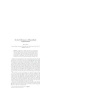10 search results - page 2 / 2 » Two-Party Generation of DSA Signatures |
IJNSEC
2010
13 years 2 days ago
2010
Digital Signature Algorithm (DSA) is an underlying algorithm to form a signature in the Digital Signature Standard (DSS). DSA uses a new random number (or nonce) each time a signa...
ACISP
2003
Springer
13 years 9 months ago
2003
Springer
In some practical circumstances, the ability of a signer should be restricted. In group signature schemes, a group member may be allowed to generate signatures up to a certain numb...
EUROCRYPT
2004
Springer
13 years 10 months ago
2004
Springer
We describe a short signature scheme that is strongly existentially unforgeable under an adaptive chosen message attack in the standard security model. Our construction works in g...
ASIACRYPT
2008
Springer
13 years 7 months ago
2008
Springer
Optimistic fair exchange (OFE) is a protocol for solving the problem of exchanging items or services in a fair manner between two parties, a signer and a verifier, with the help o...
EUROCRYPT
1999
Springer
13 years 9 months ago
1999
Springer
In this paper we discuss various aspects of cryptosystems based on hyperelliptic curves. In particular we cover the implementation of the group law on such curves and how to genera...

